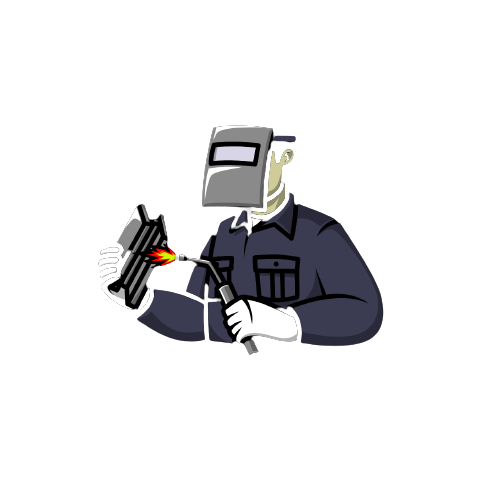There’s an art and science to maintaining your welding shirts, and a proper care regimen can ensure their longevity and performance. This isn’t just about aesthetics, it’s about preserving the fire-resistant qualities that protect you every day on the job.
Today we’ll discuss a simple caring plan for your welding shirts, helping you maintain their protective properties and keep them in top-notch condition, even in the toughest of work environments.
How to Wash Welding Shirts?
Washing welding shirts is a delicate process that requires a balance between cleanliness and maintaining the fabric’s flame-resistant properties.
Here are a few tips:
- Always check the garment’s care label before washing. It will provide specific instructions based on the fabric type and flame-resistant treatment used.
- Use a mild detergent. Avoid chlorine bleach, fabric softeners, or other chemicals that can degrade the flame-resistant properties of the fabric.
- Wash your welding shirts separately from other clothing to prevent cross-contamination of flammable residue.
- Use warm or cold water. Hot water can accelerate wear and tear on the flame-resistant fabric.
- Dry on a low setting or air dry. High heat can also wear down the flame-resistant properties.
Remember, improper washing can significantly reduce the life and effectiveness of your welding shirt. Therefore, following these tips will ensure that your protective wear remains functional and durable over time. But always remember, every shirt is unique. Always read the specific care instructions provided by the manufacturer.
How to Wash Welder Jackets?
Welder jackets, while similar in function to welding shirts, often have additional considerations when it comes to their care due to the thicker materials used and the inclusion of features like insulation and larger metal fastenings. Here’s a guide on how to wash your welder jackets:
- Always consult the care label. This step is just as important for jackets as it is for shirts, as it gives specific instructions tailored to the materials and construction of your jacket.
- Separate your jacket from other clothes. This will prevent any flammable residue from contaminating your other garments.
- Remove any detachable parts if possible. This might include a removable liner or hood, which might need separate care instructions.
- Use mild detergent. Strong chemicals can harm the flame resistance of the material and affect the durability of the jacket.
- Use cold or lukewarm water. Hot water can damage the jacket’s fabric and flame-resistant properties.
- Air dry if possible. If you must use a machine, opt for a gentle, low-heat cycle. Jackets often have metal elements that can heat up and cause damage to the garment in a high-heat dryer.
The fundamental difference between washing welder jackets and shirts lies in the construction and materials of the jackets. They are often heavier and have more complex features, making them slightly more challenging to clean.
Furthermore, due to their thicker material, they might take longer to dry. Hence, proper care should be taken to ensure they are completely dry before storage to avoid any mildew or unpleasant smells.
How often should you wash your welding shirts and jackets?
How often you should wash your welding shirts and jackets depends on the frequency and intensity of use. For those working in high-intensity, grimy conditions daily, it’s recommended to wash your garments after each use to remove contaminants that could compromise their fire-resistant properties.
However, if your work is lighter and the garments don’t get overly dirty, you might extend this to washing after every two to three wears. Remember, though, that over-washing can also degrade the materials, so aim for a balance that keeps your workwear clean and safe while also preserving its lifespan.
Can you wash leather welding shirts and jackets?
Caring for leather welding shirts and jackets poses a different challenge due to the delicate nature of leather. Unlike other materials, leather shouldn’t be tossed into a washing machine or hand-washed using conventional methods.
- Dust off: Regularly dust off your leather garment to keep it clean.
- Spot clean: If you find a stain, use a damp cloth and mild soap to gently clean the spot.
- Use leather cleaners: Specialized leather cleaners can help to remove stubborn dirt and oil stains without damaging the material.
- Keep dry: Always keep your leather welding gear dry. If it gets wet, dry it slowly at room temperature.
- Condition the leather: Use a leather conditioner to keep the material supple and prevent it from drying out and cracking.
It’s more about regular maintenance and proper handling to ensure their longevity. Always remember, when it comes to leather, professional cleaning may be your best bet for thorough cleaning without causing damage to the material.
Can Weldings Clothes be washed with detergents?
The fabric used in men’s welding clothes is often specialized to resist high temperatures and flames, and using the wrong cleaning products can potentially degrade these properties.
When choosing a detergent, consider the following factors:
- FR safe: Some detergents can potentially degrade the flame resistance of FR garments. Always opt for detergents that are labeled safe for flame-resistant clothing.
- Mild: Select a mild detergent that’s free from bleach and hydrogen peroxide. Both can damage the fabric and decrease its flame resistance.
- Non-biological: Non-biological detergents don’t contain enzymes that could potentially break down the protective layers on your welding clothing.
While detergent choice is essential, equally important is to avoid fabric softeners and bleach, which can also negatively affect your clothing’s flame resistance. Stick with a simple routine, cold water, mild detergent, and a gentle cycle.
Ultimately, your best bet would be to check the care instructions on the label of your welding garments. Manufacturers often provide specific recommendations for the best results, ensuring your welding clothes continue to protect you as they should.
Which Detergent is Best for Welding Clothes?
- Arm & Hammer Sensitive Skin Free & Clear: This detergent is hypoallergenic, dye-free, and fragrance-free, making it gentle on your welding clothes without compromising its flame-resistant properties.
- Tide Free & Gentle: This detergent is also a good choice as it is free from dyes and perfumes. It’s gentle on clothes and excellent for washing flame-resistant fabrics without degrading their protective capabilities.
- Seventh Generation Natural Laundry Detergent: This detergent is plant-based, making it a gentler choice for your welding clothes. It’s also free from dyes, artificial brighteners, and fragrances, making it safe for washing flame-resistant garments.
How to Remove Stains for Welding Shirts & Jackets?
Removing stains from welding shirts and jackets can be a bit more complex than your average laundry challenge, due to the inherent flame-resistant properties of these garments. Here’s a simple way to remove those stubborn spots:
- Pre-treat Stains: Before washing, apply an FR-safe stain remover directly to the stain. Remember to read the stain remover’s instructions and ensure it’s safe for use on flame-resistant fabric.
- Scrub Gently: Use a soft brush or an old toothbrush to gently scrub the stain remover into the fabric. Avoid vigorous scrubbing, as it can damage the fabric.
- Rinse Well: Rinse the treated area well with cold water. Never use hot water, as it can set certain types of stains.
- Wash Immediately: Wash the garment immediately after treating the stain. Use mild detergent and cold water. If the stain persists, repeat the process.
- Air Dry: After washing, air dry the garment. Avoid using the dryer as high heat can cause the stain to set and damage the flame-resistant properties of the fabric.
It’s crucial to maintain the integrity of your flame-resistant clothing. If a stain can’t be removed after several tries, it may be best to replace the garment to ensure your safety on the job.
How Long Do Welding Shirts & Jackets Last?
The lifespan of men’s welding shirts and jackets largely depends on several factors including the quality of the material, frequency of use, and how well they are cared for. Typically, high-quality flame-resistant welding shirts and jackets can last anywhere between 12 to 36 months with proper care and regular use.
Furthermore, even if a welding shirt or jacket may seem in good physical condition, its flame-resistant properties could deteriorate over time, especially if not washed and maintained correctly. Therefore, regardless of the physical condition, it’s crucial to replace your welding shirts and jackets periodically to ensure they provide maximum protection.
Regular inspection for signs of wear, tear, or any damage that could compromise your safety is also essential. Always remember, when it comes to protective gear, it’s better to be safe than sorry.
Can you machine-dry Welding shirts and jackets?
Yes, you can machine-dry welding shirts and jackets, but with some necessary precautions. It is recommended to tumble dry them on a low heat setting. High temperatures can potentially damage the flame-resistant properties of the fabric.
Moreover, avoid using any fabric softeners or bleach, as these products can coat the fibers and diminish their flame-resistant qualities. Also, remember to remove the garments promptly from the dryer to prevent unnecessary wrinkling.
If your men’s welding shirt or jacket still has some residual moisture after the drying cycle, it’s perfectly fine, as it’s better to let them air dry completely rather than expose them to excessive heat.
How to take care of Welding Clothes?
Maintaining the longevity of your welding clothes involves simple daily habits that can significantly contribute to their lifespan. Proper care doesn’t just ensure that your workwear lasts longer, but also retains its flame-resistant properties and keeps you safe.
- Keep them clean: Regularly washing your welding clothes helps to remove flammable residue. However, ensure not to over-wash, as it can wear out the material over time.
- Avoid direct sunlight: While drying, avoid direct sunlight as ultraviolet rays can deteriorate the fabric’s quality and flame-resistant properties.
- Mend minor damages: If there are any minor tears or rips, mend them immediately to prevent further damage.
- Use gentle washing and drying methods: Overly vigorous washing or high-heat drying can lead to premature wear and tear. Opt for mild washing cycles and low heat drying.
- Store properly: Store your welding clothes in a cool, dry place. Avoid damp or humid areas that can lead to mold.
In essence, the key to increasing the lifespan of your welding clothes lies in how you handle them daily. A diligent cleaning regimen, paired with proper storage and immediate repair of minor damages, will help maintain their integrity. It’s a small investment of time and effort to ensure your safety and save money in the long run.
Which Welding Shirts and Jackets are long-lasting?
It’s important to remember that the longevity of your welding shirts and jackets highly depends on their quality, the material used, and your care routine. However, a few standout brands and models consistently offer impressive durability, making them a wise investment for any welder.
We have a FREE Guide to Men’s Welding Shirts with a detailed review of the best options available in the market. We compare the pricing, features, material, and durability of all the listed shirts to help you make a wise decision. Stay safe and keep the fire burning.

